In New Zealand's case, the figures published on NIWA's [the National Institute of Water and Atmospheric research] website suggest a strong warming trend in New Zealand over the past century:
The caption to the photo on the NiWA site reads:
From NIWA's web site - Figure 7: Mean annual temperature over New Zealand, from 1853 to 2008 inclusive, based on between 2 (from 1853) and 7 (from 1908) long-term station records. The blue and red bars show annual differences from the 1971 - 2000 average, the solid black line is a smoothed time series, and the dotted [straight] line is the linear trend over 1909 to 2008 (0.92°C/100 years).But analysis of the raw climate data from the same temperature stations has just turned up a very different result:
Gone is the relentless rising temperature trend, and instead there appears to have been a much smaller growth in warming, consistent with the warming up of the planet after the end of the Little Ice Age in 1850.
The revelations are published today in a news alert from The Climate Science Coalition of NZ:
Straight away you can see there's no slope - either up or down. The temperatures are remarkably constant way back to the 1850s. Of course, the temperature still varies from year to year, but the trend stays level - statistically insignificant at 0.06°C per century since 1850.
Putting these two graphs side by side, you can see huge differences. What is going on?
Why does NIWA's graph show strong warming, but graphing their own raw data looks completely different? Their graph shows warming, but the actual temperature readings show none whatsoever!
Have the readings in the official NIWA graph been adjusted?
It is relatively easy to find out. We compared raw data for each station (from NIWA's web site) with the adjusted official data, which we obtained from one of Dr Salinger's colleagues.
Requests for this information from Dr Salinger himself over the years, by different scientists, have long gone unanswered, but now we might discover the truth.
Proof of man-made warming
What did we find? First, the station histories are unremarkable. There are no reasons for any large corrections. But we were astonished to find that strong adjustments have indeed been made.
About half the adjustments actually created a warming trend where none existed; the other half greatly exaggerated existing warming. All the adjustments increased or even created a warming trend, with only one (Dunedin) going the other way and slightly reducing the original trend.
The shocking truth is that the oldest readings have been cranked way down and later readings artificially lifted to give a false impression of warming, as documented below. There is nothing in the station histories to warrant these adjustments and to date Dr Salinger and NIWA have not revealed why they did this.
One station, Hokitika, had its early temperatures reduced by a huge 1.3°C, creating strong warming from a mild cooling, yet there's no apparent reason for it.
We have discovered that the warming in New Zealand over the past 156 years was indeed man-made, but it had nothing to do with emissions of CO2 - it was created by man-made adjustments of the temperature. It's a disgrace.
NIWA claim their official graph reveals a rising trend of 0.92ºC per century, which means (they claim) we warmed more than the rest of the globe, for according to the IPCC, global warming over the 20th century was only about 0.6°C.
NIWA's David Wratt has told Investigate magazine this afternoon his organization denies faking temperature data and he claims NIWA has a good explanation for adjusting the temperature data upward. Wratt says NIWA is drafting a media response for release later this afternoon which will explain why they altered the raw data.
"Do you agree it might look bad in the wake of the CRU scandal?"
"No, no," replied Wratt before hitting out at the Climate Science Coalition and accusing them of "misleading" people about the temperature adjustments.
Manipulation of raw data is at the heart of recent claims of corrupt scientific practice in climate science, with CRU's Phil Jones recently claiming old temperature records collected by his organization were "destroyed" or "lost", meaning researchers can now only access manipulated data.
UPDATE:
NIWA issued a response statement regarding the charges leveled by The NZ Climate Science Coalition here.
They say:
Warming over New Zealand through the past century is unequivocal.I'm not too impressed, especially when you see where the weather station for National Institute of Water and Atmosphere (NIWA) is, right on the rooftop next to the air conditioners:
NIWA's analysis of measured temperatures uses internationally accepted techniques, including making adjustments for changes such as movement of measurement sites. For example, in Wellington, early temperature measurements were made near sea level, but in 1928 the measurement site was moved from Thorndon (3 metres above sea level) to Kelburn (125 m above sea level). The Kelburn site is on average 0.8°C cooler than Thorndon, because of the extra height above sea level.
Here is the station survey: NIWA_station_survey (PDF) and the Google Earth KML file.
Thanks to: Dieuwe de Boer who did a good portion of station surveys in New Zealand last year.
The NZ Climate Science Coalition responds:
NIWA's explanation raises major new questions
The NIWA climate controversy took a new twist tonight with the release of new data from the government run climate agency.
Reeling from claims that it has massaged data to show a 150 year warming trend where there isn't one, NIWA's chief climate scientist David Wratt, an IPCC vice-chair on the 2007 AR4 report, issued a news release stating adjustments had been made to compensate for changes in sensor locations over the years.
While such an adjustment is valid, it needs to be fully explained so other scientists can test the reasonableness of the adjustment.
Wratt is refusing to release data his organisation claims to have justifying adjustments on other weather stations, meaning the science cannot be reviewed. However, he has released information relating to Wellington temperature readings, and they make for interesting reading.
Here's the rub. Up until 1927, temperatures for Wellington had been taken at Thorndon, only 3 m above sea level and an inner-city suburb. That station closed and, as I suspected in my earlier post, there is no overlap data allowing a comparison between Thorndon and Kelburn, where the gauge moved, at an altitude of 135 metres.
With no overlap of continuous temperature readings from both sites, there is no way to truly know how temperatures should be properly adjusted to compensate for the location shift.
Wratt told Investigate earlier there was international agreement on how to make temperature adjustments, and in the news release tonight he elaborates on that:
"Thus, if one measurement station is closed (or data missing for a period), it is acceptable to replace it with another nearby site provided an adjustment is made to the average temperature difference between the sites."Except, except, it all hinges on the quality of the reasoning that goes into making that adjustment. If it were me, I would have slung up a temperature station in the disused location again and worked out over a year the average offset between Thorndon and Kelburn. It's not perfect, after all we are talking about a switch in 1928, but it would be something. But NIWA didn't do that.
Instead, as their news release records, they simply guessed that the readings taken at Wellington Airport would be similar to Thorndon, simply because both sites are only a few metres above sea level.
Airport records temps about 0.79C above Kelburn on average, so NIWA simply said to themselves, "that'll do" and made the Airport/Kelburn offset the official offset for Thorndon/Kelburn as well, even though no comparison study of the latter scenario has ever been done.
Here's the raw data, from NIWA tonight, illustrating temp readings at their three Wellington locations since 1900:
What's interesting is that if you leave Kelburn out of the equation, Thorndon in 1910 is not far below Airport 2010. Perhaps that gave NIWA some confidence that the two locations were equivalent, but I'm betting Thorndon a hundred years ago was very different from an international airport now.
Nonetheless, NIWA took its one-size-fits all "adjustment and altered Thordon and the Airport to match Kelburn for the sake of the data on their website and for official climate purposes.
In their own words, NIWA describe their logic thus.
- Where there is an overlap in time between two records (such as Wellington Airport and Kelburn), it is a simple matter to calculate the average offset and adjust one site relative to the other.
- Wellington Airport is +0.79°C warmer than Kelburn, which matches well with measurements in many parts of the world for how rapidly temperature decreases with altitude.
- Thorndon (closed 31 Dec 1927) has no overlap with Kelburn (opened 1 Jan 1928). For the purpose of illustration, we have applied the same offset to Thorndon as was calculated for the Airport.
- The final "adjusted" temperature curve is used to draw inferences about Wellington temperature change over the 20th century. The records must be adjusted for the change to a different Wellington location.
And my other question to David Wratt also remains: we'd all like to see the metholdology and reasoning behind adjustments on all the other sites as well.
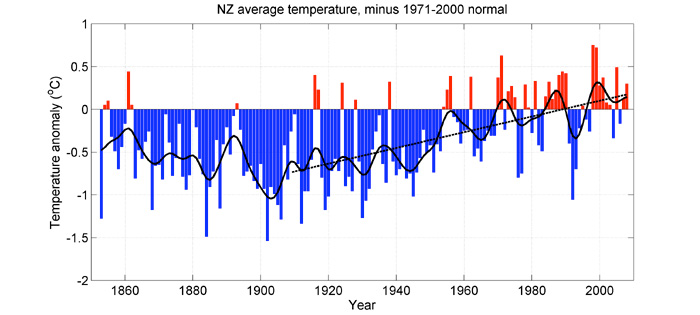
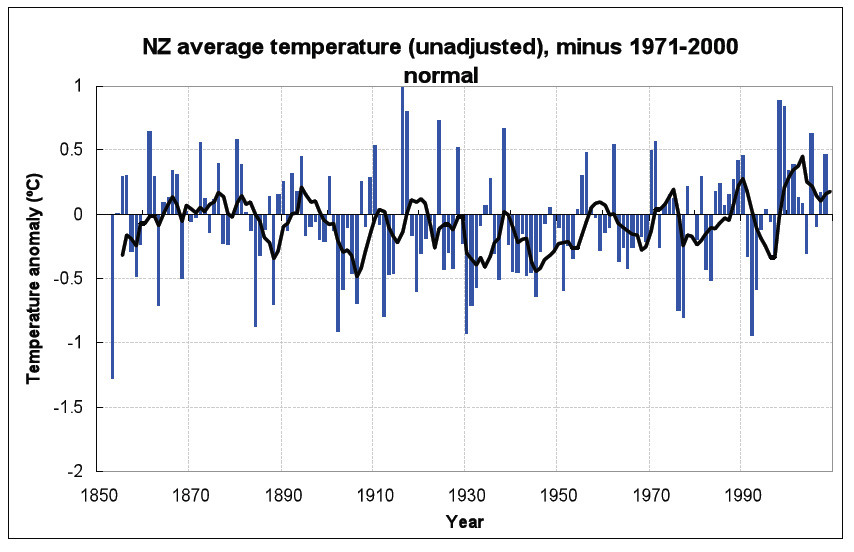
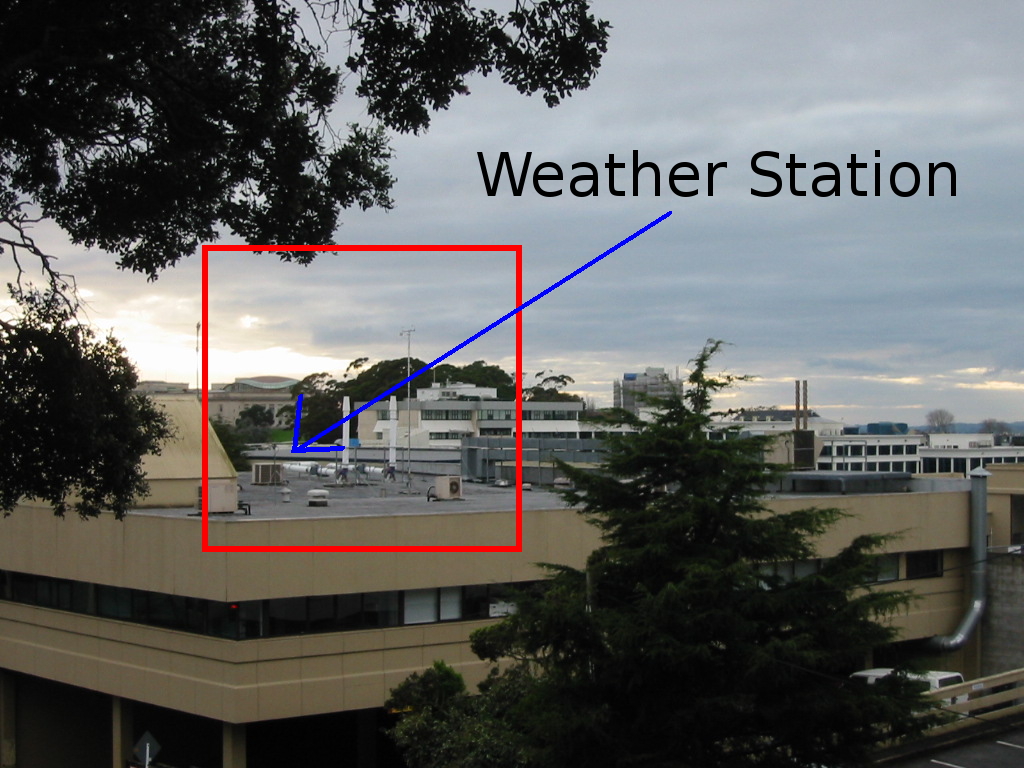
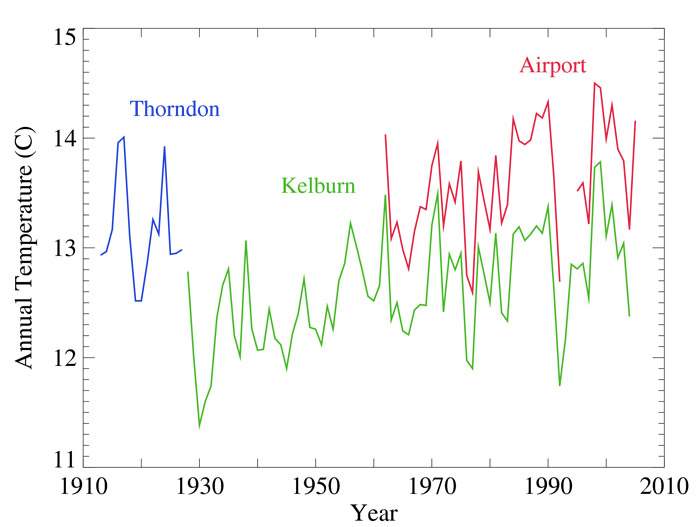
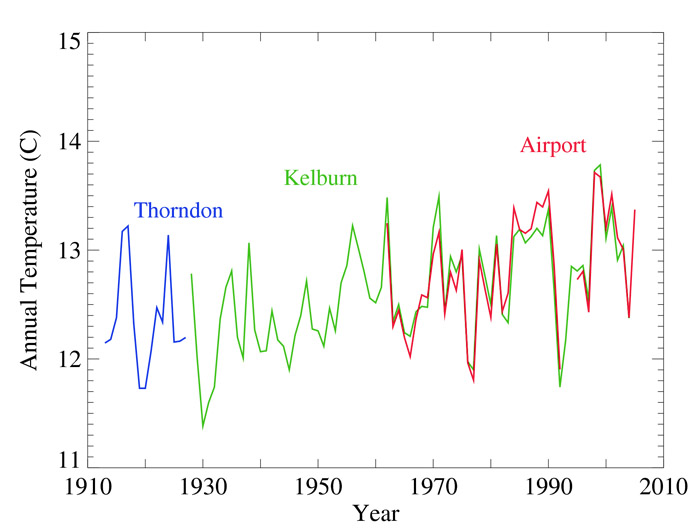



Reader Comments
to our Newsletter